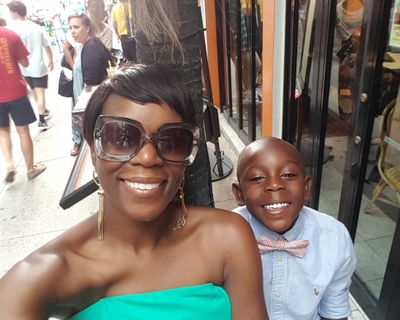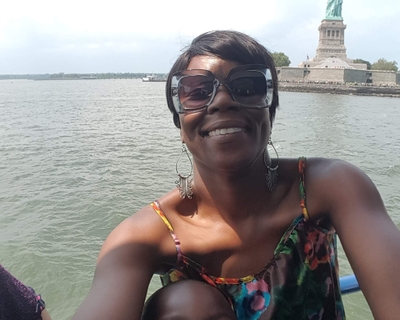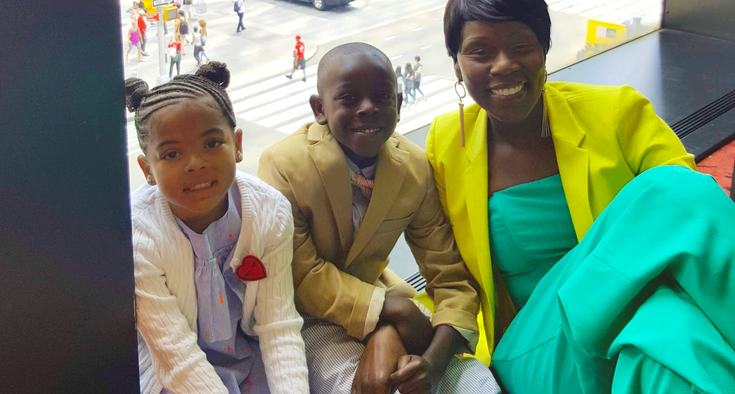Toniy Shears was drawing a bath for son Riley, then 6, when her hand brushed against her tank top. She felt a tiny knot on her chest under her left breast. It was nothing serious, she figured. She forgot about it.
Two weeks later, the knot was still there. It didn’t hurt and there was no discharge. But Shears decided to talk with her sister Tonya, a breast cancer survivor, just in case. Tonya urged her sister to get it checked out.
Shears could hardly fathom adding one more task to her schedule in the fall of 2017. Along with caring for Riley and working full-time at Novant Health Presbyterian Medical Center in Charlotte as a patient access specialist, she was just eight weeks away from earning her medical assistant diploma from Central Piedmont Community College. Finals were coming up. She didn’t need this distraction. Besides, she had received a clean mammogram less than a year before.

Still, she went ahead and saw her OB-GYN, Dr. Philip Solomon, who recommended another mammogram. After reviewing the new image, a radiologist told Shears she would need a biopsy.
Biopsy. “I didn’t hear anything else,” Shears recalled. Her mind went blank. The radiologist encouraged her not to assume the worst.
But Shears knew something was wrong when her next appointment with the radiologist included a newcomer. The additional professional was patient navigator Andrea Strayhorn, a cancer nurse who guides the patient during treatment. “I think they expected me to cry,” Shears said of that moment. “I didn’t break down. I just asked, “What’s the next step?” Shears had prayed before the appointment. “I already asked God to let his will be done. If you brought me to it, you're going bring me through it.”
'Are you going to die?'
Triple negative breast cancer is more likely to strike women before age 50. Shears was 46 when diagnosed. Other risk factors include being African American or Latina.
This cancer lacks receptors such as estrogen or progesterone commonly found in other breast cancers. For Shears, hormone therapy wasn’t an option. She would need chemotherapy. A lumpectomy would determine how far the disease had progressed.
At home, Shears couldn’t stop thinking about the work she had put in to earn her diploma and embark on a new career. She was only two months from graduation. Cancer treatment could wait, she mused, until she finished school.
It was a sign of denial. “I couldn't even answer the phone and start the process of scheduling the treatment because I didn't want to have a port,” she admitted. (A port is a small implant that sits under the skin for easier administration of treatment medications.) “Every single thing that the doctor suggested, I was like, ‘No, I don't want to do that now.’”
What made the biggest difference in her attitude was Riley. Shears decided she wouldn’t tell him all the details, but didn’t want to hide her illness from him, either. Riley asked his mom if she was going to die. “That was my turning point to say to myself, ‘Stop playing with this. Go do what you need to do.’”
She realized while it was fine to seek a second opinion, she ultimately had to trust her doctors. “I had to learn to follow the plan if I wanted to live.”
A surgeon removed four lymph nodes from Shears’ left breast during the lumpectomy. All four tested positive for cancer. She would need a mastectomy on that side. The mastectomy revealed two more cancerous lymph nodes, for a total of six. Chemo is required with even one positive lymph node.
Over the next year and a half, Shears had 16 rounds of chemotherapy and 33 rounds of radiation. A flat, dense cyst developed in her right breast once she started treatment. The cyst eventually grew to the size of a bubblegum ball. Testing showed it was not cancerous. But it scared Shears. She chose to have a mastectomy on the right side and get reconstructive surgery.
Fainting in class
In the midst of all this, Shears returned to work part-time. She left school for one semester but returned the next to complete her coursework, while receiving daily radiation.
“My teachers were like, ‘You have got to be crazy,’” she said, laughing about the attempt now. “I really felt I could do this. I didn’t have the energy, but you could not tell me I didn’t have the energy.”
Her body told her the day she passed out in class. The group had been practicing drawing blood. On other afternoons, it was tough to fight the nausea and chemo brain – the sense that new information was just not sticking. Her hands and feet felt numb sometimes. Her vision deteriorated. Her body needed time to heal. She would forego school for now.
But not forever. Her dream eventually took a new form. Maybe she could study to be a certified nursing assistant, like her sister. She had received medical training in her previous studies and didn’t want to waste it. She liked the idea of taking care of other cancer patients because someone took care of her.
If all goes well, Shears will graduate in September a CNA.
Giving it her all
Since Shears’ diagnosis, advances have been made in treatment for triple negative breast cancer. Immunotherapy has shown promising results to boost survival rates. The other factor to improve the outcome: Resist the temptation to delay care.

By starting treatment immediately, being actively involved in medical decisions, and pursuing tools for recovery such as physical therapy, patients have the best chance to preserve their health.
Shears is a role model. After her initial hesitation, she was very proactive and very involved in her care.
Shears loves to support patients and families in her current job as a medical unit receptionist on a stroke and neurology floor at the hospital. “A lot of patients are discouraged by what has happened to them neurologically. I always say, ‘I was in one of those same beds that you’re in. Hang in there and focus on what you're going to, not on what you're doing," she said.
She has seen firsthand the benefits of faith and stretching your imagination to envision what could be. Though Shears didn’t allow Riley inside her hospital room to shield him from her most difficult hours, they would chat outside the hospital during treatment. He noticed every aircraft that flew past and decided the planes were all flying to New York where Kristen, a friend from preschool, had moved. When Shears asked, “Where would you like to go when I’m better?” New York was his answer.
Once in remission, Shears called Kristen’s mom and arranged a trip to New York. Riley got to see Kristen and “The Lion King.” Shears got to see that a life with joy awaited her post-cancer.
Top photo: Toniy, her son Riley, and Riley's friend Kristen in Times Square.










